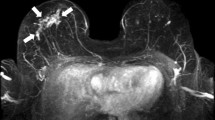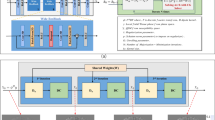Abstract
Introduction
It is a common view that consistency and blood supply of pituitary adenoma (PA) can influence the surgical effect. The aim of this study was to determine whether MRI signal intensity (SI) was correlated to the consistency or blood supply of pituitary macroadenoma.
Methods
Forty eight pituitary macroadenoma patients were underwent preoperative MRI, including precontrast and contrast-enhanced (CE) T1-spin echo (T1-SE) imaging, CE-sampling perfection with application-optimized contrasts by using different flip angle evolutions (SPACE) imaging, and perfusion-weighted imaging (PWI). The tumor consistency and blood supply were determined by neurosurgeons. The expression of collagen IV and MIB-1 was detected with immunohistology. The correlation of the relative SI (rSI) values (tumor to normal frontal white matter SI) and PWI data to the tumor consistency, blood supply, and the expression level of collagen IV and MIB-1 was statistically studied by Kruskal–Wallis rank test (K–W test).
Results
A significant correlation was observed between the tumor consistency and the rSI on precontrast T1-SE imaging (P = 0.004) but not on CE T1-SE and CE SPACE imaging. The expression of collagen IV was also significantly associated with rSI on T1-SE imaging (P = 0.010). The blood supply was correlated with the relative CBV (rCBV) (P = 0.030). In addition, the expression of MIB-1 was correlated with rSI of CE T1-SE imaging (P = 0.007).
Conclusion
Our results suggest that T1-SE imaging may be a simple and useful method for predicting consistency of PA. CBV value can provide helpful information for assessing the blood supply of pituitary macroadenoma.




Similar content being viewed by others
References
Lecoq AL, Kamenicky P, Guiochon-Mantel A, Chanson P (2015) Genetic mutations in sporadic pituitary adenomas—what to screen for? Nat Rev Endocrinol 11:43–54
Saeger W (2005) Pituitary tumors: prognostic indicators. Endocrine 28:57–66
Law M, Yang S, Babb JS et al (2004) Comparison of cerebral blood volume and vascular permeability from dynamic susceptibility contrast-enhanced perfusion MR imaging with glioma grade. AJNR Am J Neuroradiol 25:746–755
Tong T, Yue W, Zhong Y, Zhenwei Y, Yong H, Xiaoyuan F (2015) Comparison of contrast-enhanced SPACE and CISS in evaluating cavernous sinus invasion by pituitary macroadenomas on 3-T magnetic resonance. J Comput Assist Tomogr 39:222–227
Wu Y, Wang J, Yao Z, Yang Z, Ma Z, Wang Y (2014) Effective performance of contrast enhanced SPACE imaging in clearly depicting the margin of pituitary adenoma. Pituitary
Alimohamadi M, Sanjari R, Mortazavi A et al (2014) Predictive value of diffusion-weighted MRI for tumor consistency and resection rate of nonfunctional pituitary macroadenomas. Acta Neurochir (Wien) 156:2245–2252, discussion 2252
Di Chiro G, Nelson KB (1962) The volume of the sella turcica. Am J Roentgenol Radium Ther Nucl Med 87:989–1008
Chen H, Zeng XW, Wu JS et al (2012) Solitary fibrous tumor of the central nervous system: a clinicopathologic study of 24 cases. Acta Neurochir (Wien) 154:237–248, discussion 248
Suzuki C, Maeda M, Hori K et al (2007) Apparent diffusion coefficient of pituitary macroadenoma evaluated with line-scan diffusion-weighted imaging. J Neuroradiol 34:228–235
Mahmoud OM, Tominaga A, Amatya VJ et al (2011) Role of PROPELLER diffusion-weighted imaging and apparent diffusion coefficient in the evaluation of pituitary adenomas. Eur J Radiol 80:412–417
Pierallini A, Caramia F, Falcone C et al (2006) Pituitary macroadenomas: preoperative evaluation of consistency with diffusion-weighted MR imaging—initial experience. Radiology 239:223–231
Bahuleyan B, Raghuram L, Rajshekhar V, Chacko AG (2006) To assess the ability of MRI to predict consistency of pituitary macroadenomas. Br J Neurosurg 20:324–326
Chakrabortty S, Oi S, Yamaguchi M, Tamaki N, Matsumoto S (1993) Growth hormone-producing pituitary adenomas: MR characteristics and pre- and postoperative evaluation. Neurol Med Chir (Tokyo) 33:81–85
Yamamoto J, Kakeda S, Shimajiri S et al (2014) Tumor consistency of pituitary macroadenomas: predictive analysis on the basis of imaging features with contrast-enhanced 3D FIESTA at 3T. AJNR Am J Neuroradiol 35:297–303
Di Ieva A, Weckman A, Di Michele J et al (2013) Microvascular morphometrics of the hypophysis and pituitary tumors: from bench to operating theatre. Microvasc Res 89:7–14
Gelmers HJ, Beks JW, Doorenbos H (1979) Regional cerebral blood flow studies in patients with pituitary tumours. Acta Neurochir (Wien) 51:87–90
Ostertag CB, Volk B, Shibata T, Burger P, Kleihues P (1987) The monoclonal antibody Ki-67 as a marker for proliferating cells in stereotactic biopsies of brain tumours. Acta Neurochir (Wien) 89:117–121
Kontogeorgos G (2005) Classification and pathology of pituitary tumors. Endocrine 28:27–35
Kontogeorgos G (2006) Predictive markers of pituitary adenoma behavior. Neuroendocrinology 83:179–188
Wolfsberger S, Wunderer J, Zachenhofer I et al (2004) Expression of cell proliferation markers in pituitary adenomas—correlation and clinical relevance of MIB-1 and anti-topoisomerase-IIalpha. Acta Neurochir (Wien) 146:831–839
Acknowledgments
This research was supported by China Pituitary Adenoma Specialist Council (CPASC) and has received funding from the National Program for Support of Top-Notch Young Professionals, the National High Technology Research and Development Program of China (No.2014AA020611), the National Natural Science Foundation of China (No.81172391) and the Shanghai Rising-Star Tracking Program (12QH1400400) to YZ.
Ethical standards and patient consent
We declare that all human studies have been approved by the Ethics Committee at Huashan Hospital and have therefore been performed in accordance with the ethical standards laid down in the 1964 Declaration of Helsinki and its later amendments. We declare that all patients gave informed consent prior to inclusion in this study.
Conflict of interest
We declare that we have no conflict of interest.
Author information
Authors and Affiliations
Corresponding author
Additional information
ZM and WH contributed equally to this work.
Rights and permissions
About this article
Cite this article
Ma, Z., He, W., Zhao, Y. et al. Predictive value of PWI for blood supply and T1-spin echo MRI for consistency of pituitary adenoma. Neuroradiology 58, 51–57 (2016). https://doi.org/10.1007/s00234-015-1591-8
Received:
Accepted:
Published:
Issue Date:
DOI: https://doi.org/10.1007/s00234-015-1591-8




